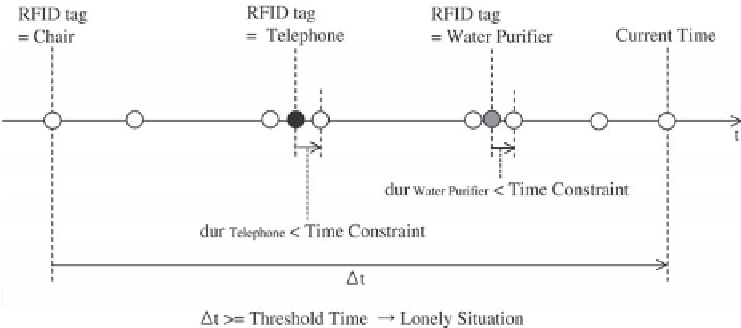Information Technology Reference
In-Depth Information
meaningful works and therefore, Duration shall be checked excluding meaningless
works. If one sits on a chair continuously and use telephone for 30 seconds and again
use in the middle water purifier for 45 seconds, these do not satisfy Time Constraint
and as they are meaningful works, only time sitting on a chair shall be checked
excluding these two events.
Fig. 5.
Data Model for Case 2
Looking at Fig. 5, this concept can be understood more clearly. Duration is obtained
after confirming whether RFID tag of the same object is detected continuously. If objects
failing to satisfy Time Constraint come in the middle, addition of Duration of previous
objects shall be calculated excluding these objects. When addition time of Duration is
larger than Threshold time, it is considered that the aged are in lonely situation.
By confirming whether RFID tag detected presently is included in RFID tag list
after checking first whether Sensor Data came in or not, if a chair or sofa is used for a
long time, we check whether they are objects judged as lonely. After that, if Duration
RFID tag detected presently is larger than Threshold time, it is judged as lonely
situation and on the contrary, if it is smaller, all Duration of the current objects that
have satisfied Time Constraint shall be added. If addition of Duration of the current
objects that have satisfied Time Constraint is larger than Threshold time and if there
are no other objects that also have satisfied Time Constraint in the middle, it becomes
lonely situation.
Example of the rule handling Case 2
<Rules>
<Imp Name="Lonliness-Case2">
<Head>
<Predicate propName="contextType">
<Variable>u</Variable>
<Value>alone</Value>
</Predicate>
</Head>
<Body operator="and">


Search WWH ::

Custom Search